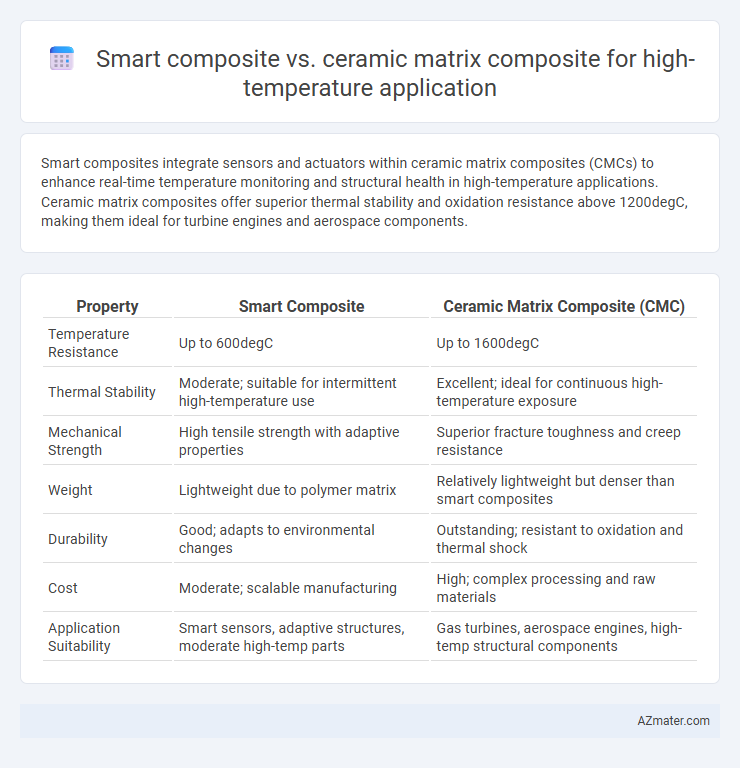Smart composites integrate sensors and actuators within ceramic matrix composites (CMCs) to enhance real-time temperature monitoring and structural health in high-temperature applications. Ceramic matrix composites offer superior thermal stability and oxidation resistance above 1200degC, making them ideal for turbine engines and aerospace components.
Table of Comparison
| Property | Smart Composite | Ceramic Matrix Composite (CMC) |
|---|---|---|
| Temperature Resistance | Up to 600degC | Up to 1600degC |
| Thermal Stability | Moderate; suitable for intermittent high-temperature use | Excellent; ideal for continuous high-temperature exposure |
| Mechanical Strength | High tensile strength with adaptive properties | Superior fracture toughness and creep resistance |
| Weight | Lightweight due to polymer matrix | Relatively lightweight but denser than smart composites |
| Durability | Good; adapts to environmental changes | Outstanding; resistant to oxidation and thermal shock |
| Cost | Moderate; scalable manufacturing | High; complex processing and raw materials |
| Application Suitability | Smart sensors, adaptive structures, moderate high-temp parts | Gas turbines, aerospace engines, high-temp structural components |
Introduction to High-Temperature Composite Materials
High-temperature composite materials, including smart composites and ceramic matrix composites (CMCs), are engineered to withstand extreme thermal environments exceeding 1000degC. Smart composites integrate sensors and adaptive features within the matrix to monitor and respond to thermal stresses, enhancing reliability in aerospace and turbine applications. Ceramic matrix composites offer superior thermal stability, oxidation resistance, and mechanical strength, making them ideal for components exposed to high heat fluxes in jet engines and industrial gas turbines.
Defining Smart Composites: Features and Functions
Smart composites integrate sensors and actuators within the material matrix, enabling real-time monitoring and adaptive responses to changing thermal stresses in high-temperature environments. These composites exhibit self-healing, shape-memory, and energy-harvesting capabilities that enhance durability and performance under extreme conditions. In contrast, ceramic matrix composites primarily focus on high thermal stability and mechanical strength but lack intrinsic sensing and adaptive functionalities.
Overview of Ceramic Matrix Composites (CMCs)
Ceramic Matrix Composites (CMCs) are advanced materials designed to withstand extreme temperatures exceeding 1200degC while maintaining structural integrity and resistance to oxidation. Unlike traditional ceramics, CMCs incorporate ceramic fibers that enhance toughness and reduce brittleness, making them ideal for aerospace and automotive high-temperature components. Their ability to maintain mechanical strength at elevated temperatures outperforms smart composites, which typically have lower thermal stability.
Thermal Stability Comparison: Smart Composites vs CMCs
Smart composites exhibit enhanced thermal stability due to their ability to adaptively respond to temperature changes, maintaining structural integrity at elevated temperatures. Ceramic matrix composites (CMCs) provide superior resistance to thermal degradation, withstanding temperatures above 1,200degC due to their inherent ceramic phase and oxidation resistance. The thermal stability of CMCs typically surpasses that of smart composites in extreme high-temperature environments, making them ideal for aerospace and turbine applications where prolonged exposure to intense heat is critical.
Mechanical Strength and Durability at Elevated Temperatures
Smart composites exhibit enhanced mechanical strength and durability at elevated temperatures through embedded sensors and self-healing capabilities, enabling real-time adaptation and damage mitigation in high-temperature applications. Ceramic matrix composites (CMCs) offer superior thermal stability and oxidation resistance, maintaining structural integrity above 1,200degC, which makes them ideal for aerospace engines and turbine components. While CMCs generally outperform traditional composites in thermal endurance, smart composites provide advanced multifunctional properties for predictive maintenance and extended service life under extreme conditions.
Resistance to Oxidation and Corrosion
Smart composites incorporate self-healing or adaptive features that enhance resistance to oxidation and corrosion at high temperatures by forming protective oxide layers, whereas ceramic matrix composites (CMCs) inherently offer superior oxidation resistance due to their stable ceramic phases like silicon carbide or alumina. CMCs maintain structural integrity and resist corrosion in extreme thermal environments, making them ideal for aerospace and turbine engine applications. Smart composites provide enhanced durability through active damage mitigation mechanisms, but CMCs outperform in long-term oxidation and corrosion stability under sustained high-temperature exposure.
Adaptability and Self-Healing Capabilities
Smart composites exhibit superior adaptability in high-temperature applications by integrating embedded sensors and responsive materials that enable real-time monitoring and self-adjustment to thermal stresses. Ceramic matrix composites (CMCs) offer intrinsic resistance to oxidation and thermal degradation but lack advanced self-healing functionalities, limiting their adaptability under variable thermal loads. The combination of smart composite technology with CMCs could enhance durability and operational lifespan by enabling autonomous damage detection and repair in extreme environments.
Application Case Studies: Aerospace and Industrial Uses
Smart composites, integrating sensors within ceramic matrix composites (CMCs), enhance real-time monitoring capabilities in aerospace jet engines, improving durability and predictive maintenance under extreme thermal stress. Ceramic matrix composites are extensively used in industrial gas turbines due to their superior heat resistance and thermal stability, enabling higher operational temperatures and fuel efficiency. Case studies in aerospace demonstrate CMCs replacing superalloys in turbine blades, while smart composites provide data-driven asset management, reducing downtime and extending component life.
Cost and Manufacturing Considerations
Smart composites offer cost advantages over ceramic matrix composites (CMCs) due to lower raw material expenses and less complex manufacturing processes, including simpler layup and curing techniques. Ceramic matrix composites require high-temperature sintering and specialized fabrication methods such as chemical vapor infiltration, driving up production costs and time. Manufacturing scalability is more feasible with smart composites, making them a preferred choice for high-volume applications despite CMCs offering superior thermal and mechanical properties.
Future Prospects and Innovations in High-Temperature Composites
Smart composites and ceramic matrix composites (CMCs) represent the forefront of materials innovation for high-temperature applications, with smart composites integrating sensors and actuators for real-time monitoring and adaptive performance. Future prospects emphasize enhancing thermal stability and self-healing capabilities through nanotechnology and advanced fiber architectures in CMCs, aiming to extend service life in aerospace and energy sectors. Innovations include embedding nano-scale reinforcements and developing multifunctional smart composites that not only withstand extreme heat but also provide critical system diagnostics, revolutionizing reliability and safety standards.

Infographic: Smart composite vs Ceramic matrix composite for High-temperature application
 azmater.com
azmater.com